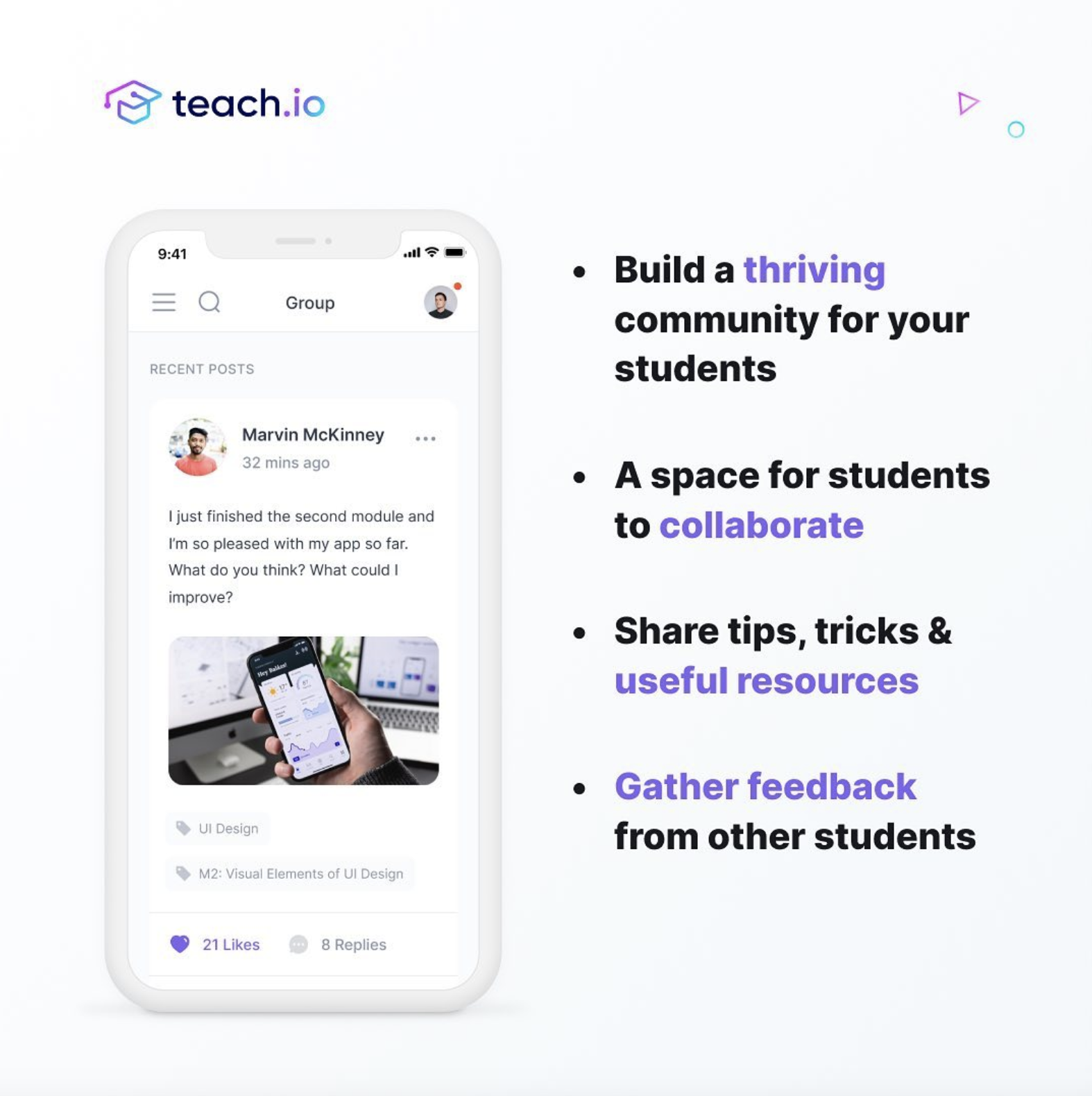In the ever-expanding realm of digital education, developing an online course is merely the first step. The real challenge emerges in effectively marketing your course to reach and engage potential learners. This guide aims to equip educational course creators with essential strategies and insights for successfully marketing online courses.
Establishing a Strong Foundation for Selling Online Courses

In the digital age, having a dedicated website for your online course is not just a luxury; it’s a necessity. This digital platform does more than just list your course details; it’s a dynamic space that showcases your expertise, highlights the unique features of your course, and serves as a magnet for potential learners.
Why a Website is Crucial for Your Course
A website acts as the central hub for all your marketing efforts. It’s where you’ll direct traffic from your ads, social media posts, and email campaigns. More importantly, it’s the place where potential students can learn about your course in-depth, understand your teaching philosophy, and decide whether to enroll.
Showcasing Course Content
Your website should effectively display what your course has to offer. This means having a well-designed course sales page that is not only visually appealing but also informative. It should outline the course curriculum, showcase testimonials, and highlight the benefits of enrolling in your course.
Building Authority and Trust
A professional website helps establish your credibility as a course creator. By providing valuable content, such as articles, case studies, or videos related to your course topic, you position yourself as an expert in your field. This builds trust with your visitors, making them more likely to consider purchasing your course.
The Role of SEO in Marketing Your Online Course

Search Engine Optimization (SEO) plays a pivotal role in the visibility of your website. The right SEO strategy can elevate your website’s ranking on search engine results pages (SERPs), making it easier for your target audience to find you.
Keyword Optimization
Using relevant keywords like “how to market online courses” and “sell online courses” throughout your website’s content helps search engines understand what your site is about. This includes integrating these keywords into your website’s meta tags, headings, and body content in a way that is natural and adds value to the reader.
Content is King
Regularly updating your blog with fresh, relevant content is a key SEO strategy. This not only helps with search engine rankings but also provides value to your visitors, encouraging them to spend more time on your site and return for more information.
Technical SEO
This encompasses optimizing your website’s backend, including improving site speed, ensuring mobile-friendliness, and having a structured site architecture. A technically sound website provides a better user experience, encouraging visitors to stay longer and explore more pages, including your course sales page.
Understanding Your Target Audience

Identifying Your Ideal Student
Identifying your ideal student goes beyond mere demographics; it’s about delving into the psyche and everyday challenges of your potential learners. Begin by mapping out the personas of those who would benefit most from your course. What are their professional goals? What obstacles do they face in achieving these goals? Understanding these aspects will allow you to tailor your course content and marketing messages to speak directly to their needs, making your course an irresistible solution to their problems.
Furthermore, engage in active research to solidify your understanding of your ideal student. This can include surveys of your existing audience, interviews with potential students, or participation in online forums and social media groups where your target demographic congregates. Pay attention to the language they use, the questions they ask, and the content they interact with. This insight will not only aid in fine-tuning your course material but also in crafting marketing messages that resonate deeply, making your course stand out as the perfect choice for them.
Creating Buyer Personas
Developing detailed buyer personas can be a game-changer. These are semi-fictional representations of your ideal students based on market research and real data. Personas help tailor your marketing content and strategies to meet the specific needs and preferences of your target audience.
Tailoring Your Message
Once you understand your audience, you can craft your website’s content to speak directly to them. This includes using language that resonates with them, addressing their pain points, and highlighting how your course offers the solution they’re seeking.
Segmenting Your Audience
If your course appeals to different groups, consider creating segmented content on your website. This could mean having different landing pages for each segment, each tailored with specific messaging that appeals to that group’s unique needs and desires.
Establishing a strong online presence through a dedicated website and understanding your target audience are foundational steps in selling online courses. A well-designed website, optimized with SEO best practices, and content that resonates with your target audience, sets the stage for a successful online course. By focusing on these key aspects, you position your course to not just attract potential learners but to convert them into enrolled students.
Developing a Robust Marketing Strategy for Online Courses

Developing a marketing strategy for your new online course involves a multi-faceted approach. From crafting valuable content and leveraging the power of guest posting to effectively using email marketing and social media platforms, each element plays a critical role in attracting and retaining students.
By implementing these strategies, you can build a robust online presence, establish authority in your field, and ultimately drive enrollments for your course.
Elevating Your Course Through Content Marketing
In the digital realm, where information is plentiful but true wisdom is scarce, content marketing emerges as a beacon for online course creators. It’s not just about broadcasting your presence; it’s about enriching the digital ecosystem with valuable insights, advice, and updates related to your course. This strategy doesn’t merely attract an audience; it captivates and cultivates a community eager to learn from you, thereby fostering profitable actions and loyalty.
Imagine your blog as a virtual classroom or a fireside chat, where each post serves as a lesson or a story that enriches the reader. Here, you’re not just an instructor but a guide, offering wisdom that positions you as a beacon of authority in your field. Craft each piece of content to be a treasure trove of knowledge, weaving in essential keywords such as “online course creators” and “course marketing strategy” to ensure search engines and seekers alike can find your insights.
Beyond the written word, the power of visual storytelling through infographics and videos cannot be understated. These tools distill complex topics into bite-sized, visually appealing pieces of content that not only cater to visual learners but are also perfect for sharing. Whether it’s through the detailed anatomy of an infographic or the dynamic narrative of a video, these formats extend your reach, bringing the essence of your course to life on various platforms, from social media to your very own course landing page.
Leveraging Guest Posting to Broaden Your Course’s Horizon

Guest posting stands as a potent strategy for online course creators aiming to amplify their visibility and establish authority. By contributing an insightful blog post to reputable platforms within your niche, you not only inherit a slice of their credibility but also expose your online course to a broader, already engaged audience. This method can be particularly effective in drawing attention to your course from individuals genuinely interested in your area of expertise.
Crafting Compelling Guest Posts
The art of guest posting goes beyond merely writing articles; it’s about enriching the host platform with unique perspectives and deep dives into subjects that resonate with their audience and yours. Here’s how you can maximize the impact of your guest posts:
- Research and Target Appropriately: Identify blogs or platforms that not only align with your niche but also house an audience that would benefit from your course. Understand the type of content they typically publish and how your expertise can add value to their readers.
- Offer Unparalleled Value: Your guest post should be more than informative—it should be transformative. Offer actionable advice, novel insights, or in-depth analysis on topics that are both relevant to the platform’s audience and reflective of your course’s content. This approach not only captivates readers but also positions you as a thought leader.
- Seamlessly Integrate Your Course: While the primary aim of your guest post should be to provide value, it’s also a strategic move to funnel interested readers towards your course. Do this subtly by integrating examples, case studies, or anecdotes from your course into your content. Where appropriate, include a call-to-action (CTA) that invites readers to explore your course for deeper insights.
- Optimize for Search Engines: Enhance the discoverability of your guest post by incorporating relevant keywords that potential students might use to search for online courses like yours. However, ensure that keyword integration feels natural and doesn’t detract from the quality of your content.
- Follow Up with Engagement: After your guest post is published, stay active in the comments section to engage with readers. Answer questions, provide additional information, and thank readers for their feedback. This not only amplifies your reach but also builds a personal connection with the audience.
By strategically guest posting on platforms that resonate with your target audience, you can significantly boost the visibility of your online course. Remember, success in guest posting is not just measured by immediate course sign-ups but also by the long-term relationships and reputation you build within your niche community.
Email Marketing: Nurturing Leads

Email marketing remains a potent tool for direct communication with potential and current students.
Building an Email List
Start by collecting email addresses through your blog, social media channels, or a landing page on your own website. Offer something of value, like a free mini-course or a compelling newsletter, in exchange for their email.
Crafting Engaging Email Campaigns
Your email campaigns should provide consistent, valuable content to your subscribers. This could be updates about your course, insights into the topic you’re teaching, or exclusive offers.
Creating a Lead Magnet
A lead magnet is a free item or service provided in exchange for contact details. It’s an effective way to build your email list and engage potential students.
Ideas for Lead Magnets
- A free email course offering a snippet of your main course.
- Downloadable resources such as eBooks, templates, or checklists.
- Access to an exclusive webinar or Q&A session.
Leveraging Social Media

Social media platforms offer a vast arena for promoting your course. They allow for direct engagement with your audience and can be a source of valuable feedback.
Facebook Groups and YouTube Channels
Joining or creating Facebook groups related to your course topic can connect you with potential students. Similarly, a YouTube channel can serve as a visual extension of your course, offering free content that complements the paid material.
Regular Updates and Engagement
Keep your social media profiles active with regular updates. Share snippets of your course content, engage with comments, and provide insights into the course creation process. Paid promotions, like YouTube ads, can also boost visibility.
Elevating Your Online Course With Advanced Marketing Techniques

In the vast and expanding universe of online education, merely possessing a top-tier course isn’t enough to secure the spotlight. To truly distinguish your offerings and captivate potential learners, it’s essential to delve into more sophisticated marketing techniques.
These strategies don’t just aim to capture the attention of potential enrollees; they’re designed to kindle interest, nurture engagement, and ultimately, convert curiosity into commitments. Below, we explore dynamic approaches to propel your online course to new heights.
Harnessing the Power of Webinars and Live Sessions

Engaging Your Audience Through Real-Time Interaction
The allure of webinars and live sessions lies in their capacity for immediate, interactive engagement. Unlike static content, these live interactions offer a platform where potential learners can immerse themselves in the essence of your teaching style and the depth of your content firsthand. This level of interaction not only demystifies the learning experience but also personalizes it, offering a glimpse into the enriching journey that awaits them.
Showcasing Your Expertise and Course Content
Utilizing webinars and live sessions as showcases for your expertise serves multiple purposes. They act as a conduit for sharing valuable insights, offering teasers of your course content, or addressing common questions and challenges within your field.
This approach not only reinforces your stature as an authority on the subject but also stirs up excitement and anticipation for what your full course has to offer. It’s a strategic way to introduce potential students to the caliber of education and transformation they can expect, making the decision to enroll a much easier leap.
Cultivating Meaningful Relationships
The interactive nature of live sessions and webinars transcends conventional marketing tactics by facilitating a genuine connection between you and your audience. This connection is pivotal. When potential students feel understood, valued, and inspired, their likelihood of taking the next step and enrolling increases significantly.
These sessions provide a unique opportunity to build rapport, answer questions in real-time, and tailor your responses to the individual concerns and curiosities of your audience. It’s about creating a community feel that welcomes questions, celebrates curiosity, and fosters a sense of belonging and excitement for what’s to come.
Harnessing Affiliate Marketing to Broaden Your Audience

Affiliate marketing represents a symbiotic relationship between your course and partners who share your target audience. By engaging with individuals or entities willing to promote your course, you tap into new networks, each with the potential to significantly boost your course’s visibility.
Crafting a Robust Affiliate Program
The essence of a successful affiliate program lies in its simplicity and clarity. By providing unique referral links and equipping your affiliates with comprehensive marketing materials and insights, you enable them to promote your course effectively. It’s crucial that these partners are aligned with your course’s values and audience, ensuring authentic and persuasive endorsements.
Elevating Your Course with Influencer Collaborations
The influence of respected voices in your field can be transformative for your course’s reputation and reach. Influencer partnerships offer a direct channel to engaged audiences, imbuing your course with a level of credibility and allure that’s hard to achieve through traditional marketing alone.
Crafting Collaborative Influencer Campaigns
The most impactful influencer campaigns are born from genuine collaboration and shared goals. By working closely with influencers, you can co-create content that genuinely resonates with their followers, whether through insightful reviews, engaging sponsored content, or exclusive offers. The key is to ensure these collaborations feel authentic and provide real value to the audience, thereby naturally drawing them towards your course.
Maximizing Reach with Paid Advertising
In a digital world where attention is the most coveted currency, paid advertising stands out as a direct and effective means to captivate potential students. Platforms like Google Ads and various social media offer sophisticated targeting options, allowing you to craft ads that speak directly to the interests and needs of your ideal audience.
Designing Impactful Ad Campaigns
The art of creating successful ad campaigns lies in a deep understanding of your audience and the unique selling points of your course. Each ad should clearly articulate the value and transformation offered by your course, tailored to the specific desires and challenges of your prospective students. A compelling narrative, combined with strategic targeting and creative presentation, can dramatically enhance your course’s visibility and attractiveness.
Utilizing Different Platforms
Explore different online course platforms to market your online course. Tailor your campaigns according to the specific audience of each social media platform. For example, LinkedIn ads might work better for professional development courses, while Instagram could be more effective for creative or lifestyle courses.
Advanced marketing techniques, including webinars, affiliate marketing, influencer collaborations, and paid advertising, can significantly elevate your course’s visibility and appeal. Each of these strategies requires a thoughtful approach, understanding of your audience, and alignment with your overall marketing goals.
By effectively utilizing these techniques, you can attract more website visitors, engage potential customers, and ultimately increase enrollments for your online courses. Remember, the key to a successful marketing campaign is not just reaching out to a large audience but connecting with the right audience in a meaningful way.
Optimizing the Sales Funnel for Your Online Course

In the journey of marketing an online course, one of the most crucial steps is optimizing your sales funnel, especially the sales page. This page is often the first detailed interaction potential students have with your course, and its effectiveness can make or break their decision to enroll. Let’s delve into how to create a compelling sales page and improve conversion rates for your online course’s launch, especially if you’re looking to create and promote multiple courses.
Crafting a Compelling Sales Page
The sales page is the centerpiece of your course’s marketing and sales funnel. Its primary goal is to convert visitors into students.
Key Elements of an Effective Sales Page
- Clear and Engaging Headline: Your headline should immediately capture the essence of your course and grab the visitor’s attention.
- Compelling Course Description: This should highlight what the course entails, what students will learn, and how it will benefit them.
- Visual Appeal: Use high-quality images, videos, and a clean layout to make the page visually engaging.
- Testimonials and Social Proof: Include testimonials from past students to build trust and credibility.
- Strong Call-to-Action (CTA): Your CTA should be clear, compelling, and encourage immediate enrollment.
- Pricing and Payment Options: Clearly display the price and make the payment process simple and straightforward.
Tailoring to Your Audience
Understand the needs and motivations of your target audience. The language, tone, and content should resonate with them and address their specific desires or challenges.
Improving Conversion Rates

Once your sales page is live, the focus shifts to analyzing and optimizing it for higher conversion rates.
Analyzing Visitor Behavior
Use tools like Google Analytics to understand how visitors interact with your page. Look for:
- Bounce Rate: How many people leave the page quickly?
- Average Time on Page: Are visitors engaging with the content?
- Conversion Rate: What percentage of visitors are enrolling?
Identifying Drop-off Points
Determine at which point potential students are leaving your sales page without enrolling. Is it at the pricing section? Or are they not convinced by the course description?
A/B Testing
Conduct A/B tests by creating different versions of your sales page. Test various elements like headlines, CTAs, images, and layout to see which version performs better.
Continuous Optimization
Optimization is an ongoing process. Regularly update your sales page based on feedback and performance data. This is particularly important if you plan to create multiple courses, as each course may appeal to different segments of your audience.
Marketing Online Courses Through Podcasts

In the digital age, podcasting has emerged as a powerful medium for storytelling, sharing knowledge, and building communities. For online course creators, podcasts offer a unique avenue to market their courses, connect with potential students, and establish themselves as thought leaders in their field.
Podcasts have gained immense popularity due to their convenience and versatility. They can be consumed on the go, making them an ideal medium for busy individuals who seek to learn or be entertained during their commute, workout, or daily chores. This accessibility makes podcasts a valuable tool for reaching a wide and diverse audience.
Amplifying Your Online Course Reach Through Podcasting
Launching a podcast can significantly enhance your online course’s visibility, allowing you to engage with potential students in a more intimate and impactful way. Below, we explore the steps and strategies to effectively use podcasting as a marketing tool for your online course.
Identifying Your Niche and Audience
The first crucial step is pinpointing the niche your course addresses. This specificity helps in crafting podcast content that appeals directly to your target audience, ensuring relevance and value in every episode. Deeply understanding the interests, challenges, and goals of your potential students allows you to align your podcast content with their needs, making your course an attractive proposition.
Planning and Producing Your Podcast
Whether it’s through engaging interviews, insightful solo episodes, or a mix of formats, selecting the one that best matches your style and audience preferences is key to creating compelling content. Planning your episodes around topics that interest your audience and tie back to your online course content is essential. This strategy not only enriches your listeners’ experience but also subtly guides them towards your course.
Investing in Quality
High-quality audio is non-negotiable in podcasting. Investing in good recording equipment ensures your podcast sounds professional, helping retain and grow your listener base. Establishing a regular publishing schedule is vital. Consistency builds a loyal audience and integrates your podcast into their regular content consumption habits.
Marketing Your Online Course Through Podcasting
Skillfully integrate mentions of your course and related stories into your podcast. This approach adds value to your content while promoting your course. Create a sense of exclusivity and urgency by offering special deals or discounts on your course to podcast listeners, encouraging them to enroll.
Expanding Your Podcast’s Reach
Guest appearances on related podcasts can introduce you to new audiences. Conversely, featuring guests on your podcast can add diversity to your content and attract their followers. Engage in mutually beneficial promotion with podcasters in similar niches to broaden your reach and introduce your course to a wider audience.
Effective Podcast Marketing Techniques
Share your episodes across social platforms to enhance visibility. Engaging with your audience online can also build a community around your podcast and, by extension, your course. Optimizing your podcast for search engines and encouraging ratings and reviews can significantly increase your visibility, attracting new listeners and potential course enrollees.
By embracing podcasting as part of your marketing strategy, you not only get to share your expertise and insights but also create a direct channel to market your online courses. This approach allows for a deeper connection with potential students, making it a powerful complement to other digital marketing efforts.
Continuous Improvement and Adaptation in Online Course Marketing

In the fast-paced realm of online education, the landscape is perpetually shifting. For educators and course creators, embracing the ethos of continuous improvement and adaptation isn’t just beneficial—it’s essential for survival and success. As digital platforms evolve and learner expectations change, staying ahead requires a proactive approach to refining your marketing strategies and course content.
The Critical Role of Feedback in Course Refinement
At the heart of continuous improvement lies the process of gathering and analyzing feedback. This invaluable insight serves as a direct line to understanding the effectiveness of your course, pinpointing areas of excellence and identifying opportunities for enhancement.
Diverse Avenues for Feedback Collection
- Post-Course Surveys and Questionnaires: Implementing detailed surveys upon course completion allows you to gather structured feedback, offering insights into the learner’s journey and experience.
- Engaging Through Interactive Sessions: Conducting live sessions or webinars not only enriches the learning experience but also opens up channels for immediate feedback, fostering a deeper connection between instructors and students.
- Leveraging Social Media and Online Forums: These platforms offer a more informal setting for feedback, where students can share their thoughts and experiences in a community-driven environment.
- Encouraging Reviews on Course Platforms: Prompting students to leave reviews or comments on your course landing page or educational platforms provides public testimonials that can guide prospective students and offer constructive feedback.
Deep Dive into Feedback Analysis
Delving into the feedback received, it’s crucial to discern patterns, recurrent themes, or specific issues raised by students. Both accolades and criticisms hold value, offering a balanced view of your course’s impact and areas ripe for improvement. This analysis can reveal actionable insights into refining course materials, teaching methods, and overall student engagement strategies.
Staying in Sync with Educational Market Trends
The online education sector is a beacon of innovation and change, constantly influenced by new technological advancements, pedagogical theories, and learner preferences.
Exploring Emerging Technologies and Platforms
Keeping abreast of new digital tools and learning platforms can significantly enhance the delivery and accessibility of your course. Whether it’s interactive content, immersive learning experiences through virtual reality, or leveraging AI for personalized learning paths, these advancements can elevate the educational experience.
Insightful Competitor Analysis
Understanding the competitive landscape is invaluable. Analyzing how peers and competitors structure their offerings, engage with their audience, and differentiate themselves can offer strategic insights and inspire innovative approaches to course development and marketing.
Adapting Content and Strategies to Market Dynamics
In response to shifting market dynamics, regularly updating your course content to reflect current trends, advancements in the field, and learner feedback ensures ongoing relevance and appeal. Similarly, adjusting your marketing strategies to capitalize on emerging trends, such as new social media channels or changes in SEO practices, can keep your promotional efforts effective and responsive to the digital environment.
Leveraging Technological Progress
The relentless pace of technological innovation presents both challenges and opportunities for online education providers. Staying informed about and integrating new tech can transform the learning experience, making education more engaging, accessible, and effective. From augmented reality case studies to AI-driven tutoring systems, technology continues to push the boundaries of what’s possible in online learning.
The journey of marketing and delivering online courses in today’s ever-evolving digital landscape demands a commitment to continuous improvement and adaptability. By actively engaging with student feedback, staying attuned to the latest trends and technological advancements, and being willing to innovate and iterate, educators can ensure their courses not only meet the current demands of the online learning market but set new standards for excellence and engagement. This proactive approach is key to standing out in the crowded and competitive field of online education, ensuring your courses remain at the forefront of learners’ minds and preferences.
Conclusion

In wrapping up this “Ultimate Guide: How To Market Online Courses for Maximum Impact and Enrollment,” we’ve journeyed through the multifaceted landscape of digital marketing strategies tailored for online courses. Whether you’ve just created your first online course or have already created multiple courses, the effectiveness of your marketing efforts is pivotal in determining their success.
We’ve explored a range of effective strategies, from leveraging the power of social media and email marketing to creating compelling sales pages and engaging content. Each strategy plays a unique role in drawing potential learners to your course, engaging them with valuable information, and guiding them towards enrollment.
Remember, the key to successful marketing is not just about reaching a vast audience but connecting with the right audience. For those who have created multiple courses, it’s about showcasing the diversity and depth of your offerings, ensuring that each course finds its unique audience.
The process of marketing online courses is dynamic and requires continuous learning and adaptation. Creating content that resonates with your target audience, optimizing sales pages for maximum conversion, and staying updated with the latest digital marketing trends are all critical elements of a successful marketing strategy.
In today’s digital age, effective course marketing is often just a few clicks away. However, these clicks should be strategic and well-informed. Utilize the tools and platforms available to you, but do so with a clear understanding of your goals and the needs of your potential students.
In conclusion, the journey to market online courses effectively is ongoing and ever-evolving. Embrace the process, be ready to adapt, and continually strive to refine your strategies. With dedication, creativity, and a focus on providing value, your courses can achieve the impact and enrollment they truly deserve.






Build once, earn forever
Are you ready to start making an income from your skills? Explore the full potential of our cutting-edge course creation platform with a 14-day FREE trial, and start earning on autopilot.
Try For Free
